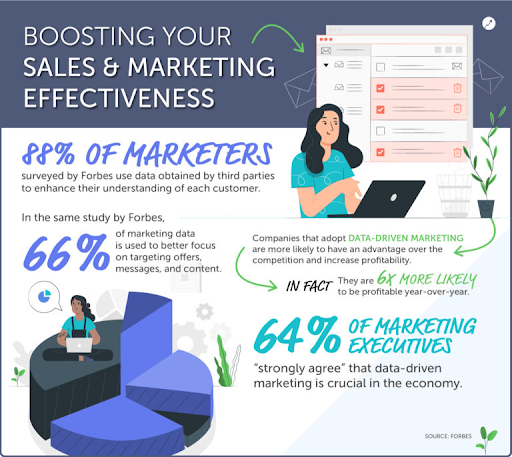The primary purpose of marketing is to communicate your brand message to the right people and to do so, you must understand how to effectively contact your target audience or target accounts. As a result, if you are selling your product or service to the wrong individuals, you are wasting both money and effort.
It might be tempting for sales reps to cast your prospecting net as broad as possible to ensure that your pipeline is full of potential consumers. In fact, many businesses advocate fat pipelines to enhance conversion rates.
While this may appear to be sensible, adding additional leads to your sales funnel might reduce the quality of your prospects.
It will be more difficult to focus your attention on the best prospects, and you will waste valuable time managing administrative procedures rather than closing agreements.
To ensure all your efforts to identify, reach, and connect with the right contact accurately aren’t wasted, you should have a focused and structured sales and marketing approach.
Here is what you can do to accurately target ideal prospects accounts.
Step 1: Knowing Your Audience is Crucial
Understanding your target demographic is critical as a marketing or sales professional. This data will serve as the foundation for any ABM plan and strategy you implement. While broadcasting an ad during the Super Bowl may appear to be a great way to reach as many people as possible, you will have to spend an outrageous amount.
Furthermore, just a small percentage of the viewers are likely to be interested in what you’re selling. Knowing that your target demographic reads a particular newspaper or watches a particular show means fewer people will view your advertisement, but they will be the correct people. If you sell running shoes, for example, adverts in running periodicals may be a better fit for your target demographic. Choosing the correct medium is critical for maximizing your marketing ROI.
Understanding your target market enables you to create relationships and communicate more effectively with customers, in addition to enhancing ROI. This is especially crucial in an era when consumers demand every advertisement to be individualized and highly targeted. Indeed, 80% of consumers think they are more inclined to do business with a brand that provides individualized encounters.
Step 2: Create Your ICP
To reach your target accounts, you must first establish who your target audience is, which requires understanding your customers.
Fortunately, building an ideal client profile (ICP), a generic picture of what your potential buyers look like, is simple to do.
The ICP is essential to sales-marketing success, especially in an account-based structure where sales and marketing collaborate closely. A strong ICP lays the path for “compelling business outcomes,” such as shorter sales cycles, higher conversion rates, and higher annual and lifetime contract values.
You will need different types of data, just as you will need different inputs for the ICP. Basic firmographic data, such as a client’s income, number of workers, or market share, is an obvious starting choice. To correctly develop ICPs and reach the relevant audience, you should additionally consider technographic and intent data.
Once you’ve completed this, you can begin selling your brand to folks who are actually interested.
As a consequence, you will boost your chances of obtaining important leads and converting them into sales, resulting in more income for your company.
Step 3: Create ICP-Based Content for Your Campaigns
Now that you know exactly who you want to reach out to, the next step is to generate relevant content that provides them with useful information.
Write on industry-specific issues that are of interest to your target audience and so capture their attention. Furthermore, the more clear and relevant your material is, the more easily it will reach your ideal clientele.
Simply said, content marketing is crucial for producing high-quality leads and meeting company objectives. You become aware of your potential customer’s pain points, needs, and interests. Create customized messaging for all collateral. Knowing your target client profile highlights the angle and direction your content must take to be relevant.
Step 4: Reach the Decision-Maker(s)
You have discovered a prospect who has everything you have ever wanted based on your ICP, and you’re confident that if you could only get an appointment with their top executive, they’d buy from you.
What are you going to do? You could just call and request an appointment, but so many things may go wrong, and you want to make the most of the opportunity.
If you want to reach the stars, go straight to the top.
You might have to face the gatekeepers that could make it difficult for you to talk to the decision-maker. However, if you can break the gatekeepers no more questions code and know how to ask for it the proper way, gatekeepers are fantastic information providers.
Step 5: Use Verified Direct Dials to Boost Sales Cycle
If you dial a company’s switchboard number and request a decision-maker from upper management, the gatekeeper will almost certainly deny you access. When utilizing switchboard numbers, it takes an average of 22 minutes to connect, but just five minutes when using direct dial numbers.

One of the keys to successful prospecting is learning how to obtain direct-dial phone numbers. With the advancement of gatekeeper cracking and data protection, obtaining direct dials is usually easier said than done. However, it is worthwhile to make an effort to find them.
Work mobile numbers can assist you and your sales team with:
- Fastracking higher-level decision-maker outreach
- Overcoming call reluctance
- Seeing higher sales productivity and ROI
- Easing sales enablement and training
The typical approach to acquiring numbers is to direct your sales team to play treasure hunter on various platforms and websites, which reduces the amount of time spent calling and pitching DMs. Worse, when they find phone numbers, they seldom find direct dial numbers and even fewer work mobile numbers.
You Need The Right Data, At The Right Time
Comprehensive B2B data is at the heart of any efficient marketing and sales plan. It makes no difference if you have a small or large business; having the correct information as your basis is critical.
Accurate contact information is essential for generating leads and increasing income. A well-organized and accurate B2B communication database will boost marketing and sales initiatives by ensuring that the correct prospects are targeted.

Choosing the right B2B data will have a direct influence on the effectiveness of your marketing and sales strategy. The B2B data categories listed below must be included in your database to enable a more concentrated approach to your marketing efforts as well as tailored sales messages to your prospects and leads.
Firmographic Data
Firmographic data offers crucial corporate facts that assist you in categorizing accounts (companies) that are appropriate for you. Firmographics offer the same importance for corporations in their PR and sales efforts as demographics do for individuals.
Technographic Data
Technographic data consists of technologies that are used by your target accounts/companies.
Intent Data
Intent data examines the intentions of those in your target accounts. It shows where a prospect is on the buyer’s journey and whether they are a solid lead-to-account match. Firmographic and technographic data will assist you in sorting accounts, while intent data will give you information on the behaviors of the persons behind these accounts so you can prioritize ready-to-buy prospects.
Intent data can help you understand buying intent based on topics or keywords that your target accounts/contacts are seeking, and social media engagement.
Accurate Contact Data
These are the important items– consider the contact information to be the enabler or key information that allows you to contact the people behind the accounts on the list and sell.
The following information is included in the contact information:
- Name of Contact
- Job title
- Business Email address
- Account on LinkedIn
- Direct-dial numbers
Access the Accurate Must-Have Data On One Platform
Businesses are often compelled to make a trade-off between data quantity and data quality. Data quality enables you to perform the most effective outreach, with targeted content, to the correct decision-makers at firms that are ready to buy now. Data quantity, on the other hand, levels the playing field by identifying more chances to create more leads and establish a larger pipeline.
We understand how important it is for your sales staff to have both accuracy and quantity. As a result, SalesIntel enables you to find and target millions of decision-makers in B2B industries such as IT, Education, Finance and Banking, Recruitment, Professional Services, and others. Furthermore, SalesIntel delivers technographic, firmographic, and Buying Intent Data allowing you to filter organizations based on the technologies they employ, company size, geography, buying intent signals, and other factors.
Many data providers provide machine-verified data based on artificial intelligence and machine learning, or they employ algorithms for guessing contact information. For example, they may presume that an email pattern such as firstname.lastname@companyname.com applies to the whole business and apply this rule to emails sent to all workers without checking the data at the individual level.
To ensure the greatest degree of trustworthiness, SalesIntel goes the additional mile and runs all of our data through human verification before publishing it to our portal. And, the data is re-verified every 90 days.
Want to access the data that matches your ICP and find untapped opportunities?





